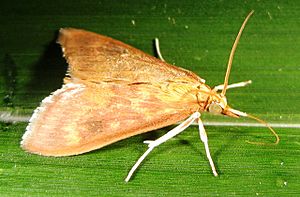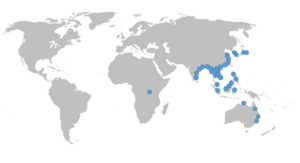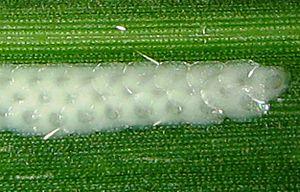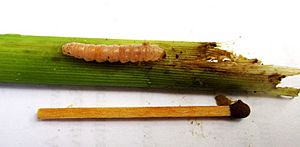Ostrinia furnacalis facts for kids
Quick facts for kids Ostrinia furnacalis |
|
|---|---|
 |
|
| Scientific classification | |
 |
|
| Distribution of Ostrinia furnacalis | |
| Synonyms | |
|
The Asian corn borer (scientific name: Ostrinia furnacalis) is a type of moth from the family Crambidae, also known as grass moths. It was first described in 1854 by Achille Guenée. This moth is called the Asian corn borer because it lives in Asia and mostly eats corn plants.
You can find the Asian corn borer in many places, from China all the way to Australia. This includes islands like Java, Sulawesi, the Philippines, and New Guinea. The Asian corn borer is part of a group of very similar moths. It can be hard to tell them apart just by looking at them.
This moth has a cool trick: it can copy the sounds that bats make when they hunt. It uses this sound to make female moths stop moving, which helps the male moth mate. The Asian corn borer is also a big problem for farmers because it damages many crops, especially corn. It is one of the worst corn pests in Asia. Scientists are working hard to find ways to get rid of this pest. They are trying different methods, including using natural enemies and special substances.
Contents
Where the Asian Corn Borer Lives
The Asian corn borer is most common in Asia and Southeast Asia. You can find it in countries like China, the Philippines, Indonesia, Japan, and Korea. It also lives in a few other places, such as the Solomon Islands and parts of Australia.
These moths love tropical areas. This is because farmers in these warm countries grow their favorite food crops all year long. This gives the moths a steady supply of food.
What the Asian Corn Borer Eats
The main food for the Asian corn borer is corn. But it also eats and damages other plants. These include bell peppers, cotton, sugarcane, and different types of millet and sorghum.
It can also be found on wild plants. Some of these wild plants are wormwoods, Job's tears, and different kinds of wild grasses.
How Larvae and Pupae Eat
Young Asian corn borer larvae start by eating the underside of corn leaves. As they grow, they move to the top part of the plant, called the tassel. Then, they feed on the corn ear, eating the silk and kernels.
Older larvae start boring into the plant's stalks. This helps them get inside the plant. They then form their pupae inside these stems. If there isn't enough food on one plant, the larvae make silk threads. They use these threads to travel to other plants. Sometimes, the wind even carries them to new plants using these silk strands.
Life Cycle of the Asian Corn Borer
The Asian corn borer goes through several stages in its life, from egg to adult moth.
Eggs
Asian corn borer eggs are laid in groups of 25 to 50. You can find them at the bottom and under the leaves of corn plants. They look like tiny scales and are laid in layers, like roof tiles.
Each egg is about half a millimeter long. They are white at first, then turn black just before they hatch. The eggs usually hatch within 3 to 10 days.
Larvae
The Asian corn borer goes through six different instar stages as a larva. The youngest larvae are pinkish with dark spots and a dark head. Older larvae are yellowish-brown with dark spots. They can grow up to 2.9 centimeters long.
Pupa Stage
After 3 to 4 weeks, the caterpillar larvae change into pupae. They stay in this stage for 6 to 9 days. They usually form a cocoon in the soil or inside the plant stem. After this, they become adult moths.
Adult Moths
Adult Asian corn borers have different colors depending on if they are male or female. This makes them easy to tell apart. Females are light yellow or tan with darker wavy lines on their wings. They are also bigger than males, with a wingspan of 20–30 millimeters.
Males are darker in color and have similar wavy bands on their wings. Their bodies are also narrower at the end. Adult moths live for about 10 to 24 days. During this time, a female moth can lay up to 1500 eggs.
Natural Enemies
The Asian corn borer has several natural enemies. These include certain types of flies and wasps. For example, the Lydella grisescens fly and the Macrocentrus cingulum wasp are parasites of this moth.
The moth can also get sick from certain fungi. These include Beauveria bassiana and Nosema furnacalis. It can also get a disease called muscardine.
How Asian Corn Borers Mate
Asian corn borers have interesting ways of finding a mate.
Sound Mimicry
During courtship, male Asian corn borers make a special sound. They rub parts of their wings against their bodies to create an ultrasound call. This sound is very similar to the echolocation calls that bats make.
Males use this trick to attract females. When a female hears this sound, she stops moving. This makes it easier for the male to mate with her. Other animals, like certain fish and water mites, also use similar tricks.
Pheromones
These moths also use special scents, called pheromones, to communicate during mating. Female moths release a sex pheromone from a gland in their body. This scent tells males that they are ready to mate.
When males smell these pheromones, they often release their own scent signals. These signals come from special structures called hair-pencils. This helps the male to mate.
Offspring Ratios
Sometimes, there are more female Asian corn borers born than males. This can happen because of a tiny bacteria called Wolbachia. This bacteria can cause more female moths to be born.
Scientists found that if they give the female moths an antibiotic that kills Wolbachia, they will have mostly male offspring. This unusual ratio has mostly been seen in Japan.
How the Asian Corn Borer Works
These moths have some interesting physical abilities and ways of surviving.
Flight
Adult Asian corn borers are strong fliers. They are active at night and can fly several miles in one night. They might fly long distances to find mates. Flying a lot can also affect how many eggs a female lays.
If the air is not humid enough, it can be harder for the adult moths to fly.
Antennae
The Asian corn borer has important antennae on its head. These antennae have special parts called sensilla. These parts help the moth sense things around it.
They help the moth smell things, which is important for finding mates and places to lay eggs. Males are very good at sensing the chemicals released by females. The antennae also help them feel things, sense temperature, and detect humidity.
Diapause
Diapause is like a pause in an insect's development. It happens when the weather or other conditions are not good for them. Asian corn borers usually go into diapause during the cold winter months.
During diapause, their oxygen levels stay high. However, their glycerol levels change. Glycerol is like a natural antifreeze that helps them survive the cold. It increases a lot in December and January, helping the moth resist cold weather.
Asian Corn Borer and Humans
The Asian corn borer can cause big problems for farmers.
Damage to Crops
This insect can cause huge losses in corn fields. In the Philippines, farmers have reported losing 20% to 80% of their corn crops. In Taiwan, losses have reached 95%, and in the Marianas, it has been 100%.
The moth's larva does most of the damage. It eats almost all parts of the plant. It bores into the corn ear to eat the silk and kernels, destroying the fruit. It also bores into the stem to make a cocoon for pupation, damaging the stalk. Larvae also feed on the tassels, eating the pollen.
Controlling the Pest
Farmers use different methods to control the Asian corn borer.
Biological Control
One way to control the moth is by using its natural enemies. For example, a tiny wasp called Trichogramma ostriniae lays its eggs inside the moth's eggs. This stops the moth eggs from hatching. This method, called biological pest control, has had different levels of success.
Other wasps, like Trichogramma dendrolimi, are also used. Another insect, the earwig Euborellia annulata, also helps control this pest. Some bacteria that live in tiny worms can also kill the Asian corn borer very quickly. Farmers also remove the tassels from corn plants. This reduces the number of larvae that feed on them.
Using Special Substances
Like the European corn borer, the Asian corn borer can be controlled using Bt corn. This is a type of corn that has been modified to produce a natural substance called Bt toxin. This toxin harms the moth when it eats the corn.
Bt corn has been used in the Philippines and has helped farmers get more corn from their fields. Bt cotton has also worked well in China. Another trick is to plant some corn plants among cotton plants. The moths prefer to spend the winter in the corn, which protects the cotton. Farmers also use special sprays and try to grow corn plants that are naturally resistant to the moth.



